An insulated jacket can help you stay comfy when conditions are cold, or warm up when the weather unexpectedly takes a turn for the worse. Not all insulated jackets are the same: Some puffers are thick garments perfect for wearing to a winter sporting event. Other puffy jackets are more breathable for activities like snowshoeing and skiing. This can make it hard to choose! Whether you’re looking to add warmth to your ski fit or stay cozy around the campfire, we’ll help you pick the right layer.
We talked to REI department manager Arianna Ross, who has five years of experience outfitting customers for freezing, wet winters in Columbus, Ohio, about how to find an insulated jacket that’s right for you. We also spoke with Britt Berg, a senior outerwear designer for REI who helped create the popular REI Co-op Magma 850 Down Hoodie and the First Chair and Powderbound snow collections.
Below, this article breaks down:
Editor’s note: We significantly updated this article on Nov. 12, 2025, to include new and current subject matter expertise on insulation types and how to pick the right jacket for your activity, as well as new charts and links.
What Is Insulated Outerwear?
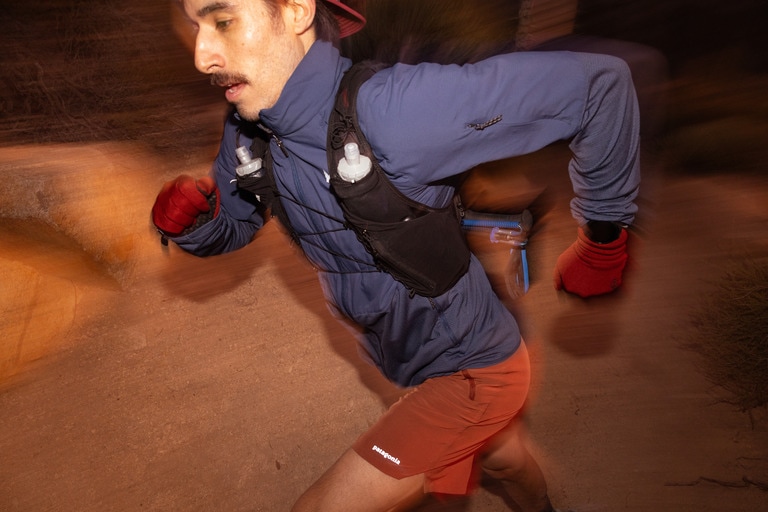 | 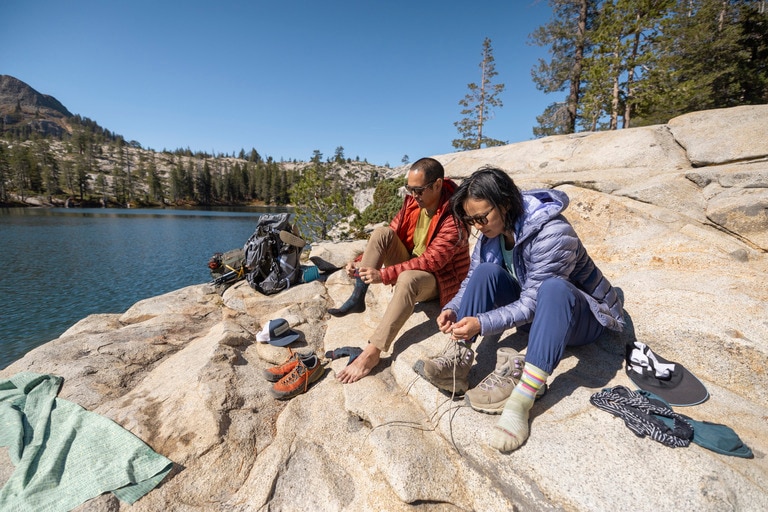 |
Insulated jackets have a special type of material, sometimes called “fill,” designed to trap warm air and hold it close to your body. If you’ll be outside when conditions are so cold that a mid layer like a fleece won’t cut it, you need insulated outerwear.
But insulated jackets aren’t only for winter. They come in handy while sitting around the campfire on crisp summer evenings, layered under a shell during spring skiing adventures, and when you’re hitting the trail before sunrise in any season.
How to choose depends on how cold you tend to run and the things you like to do outside. Special features—like a hood, venting and/or powder skirt—and whether you plan to travel with your jacket are also important factors.
Insulation Types: Down vs. Synthetic
Start here when choosing. The right insulation type for you will depend on how cold you tend to run, where you’re recreating and what you plan to do.
Pros | Cons | Ideal for | |
|
|
| |
|
|
| |
|
|
|
Down Jackets
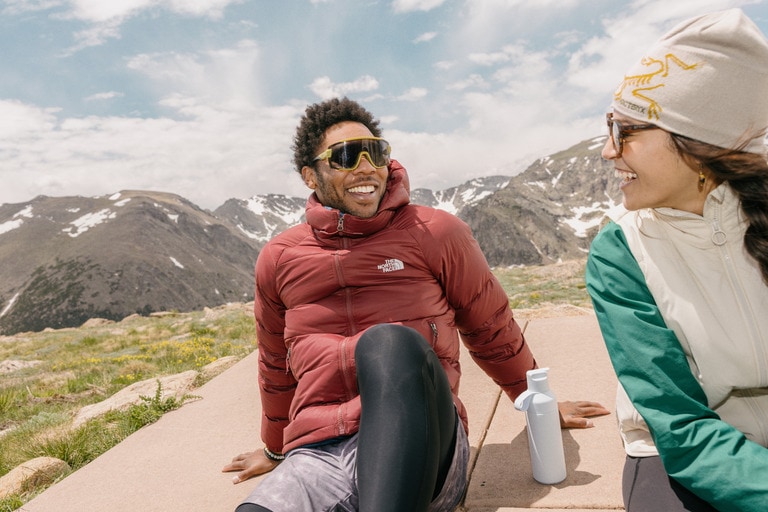
If you’ve ever noticed feathers poking out from your pillow or bed comforter, you’re familiar with down insulation. Down jackets are filled with feathers from ducks or geese. A key benefit of down is that it has small air spaces within the down “plumules” (superfine, featherlike plumage) that trap heat and keep you warm.
Down is warm, lightweight and compressible, easy to pack down when you’re backpacking or traveling. But the feathers take a long time to dry if they get wet, which can leave you feeling cold and clammy. If you anticipate rain, snow, humidity or being active enough to break a sweat, look at water-resistant down, synthetics or down/synthetic hybrids.
Water-resistant down is treated with a chemical that helps water bead up and slide off the garment, so you don’t end up soaked. “What that treatment is doing is creating a barrier, which allows the water to bead up and roll off [the face fabric] as opposed to getting absorbed into the natural fibers,” Ross says. Down and water-resistant down tends to be more expensive than synthetic insulation.
What Is Fill Power?
You might have seen jackets advertised as having “650-fill-power down” or “800-fill-power down.” Fill power is the volume in cubic inches that one ounce of the down fills up. Pay attention to fill power if you’re trying to save weight and space in your pack. The higher the fill power, the easier it will be to compress or pack the jacket away.
Fill power is different from fill weight or the weight of the insulation, measured in grams or ounces. A higher number tells you that the insulation is heavier and therefore warmer but less compressible.
Insulated jackets don’t receive temperature ratings the way sleeping bags do. This can make it difficult to compare two similar insulated jackets. In general, Ross tells her customers that the thicker or puffier the jacket, the warmer it’s likely to be. Read What Is Down Fill Power? for more information.
Down benefits:
Very warm for its weight
Lightweight
Compressible and packable for travel or backpacking
Down disadvantages:
Doesn’t retain warmth when wet, making it less ideal for sweaty activities or wet conditions
More expensive than synthetic options
Use it for:
A casual around-town layer in cold, dry environments
A mid layer under a weatherproof jacket (shell) when downhill skiing or snowboarding
Warming up around the campfire when rain isn’t expected
Coaching or spectating outdoors, under a parka or shell jacket
Synthetic Insulation Jackets

Synthetic insulation is made from human-made, water-repellent fibers like polyester. The main benefits of synthetic insulation are that it performs when damp, dries fast and is usually more affordable than down. “I think a lot of people think of down as the holy grail of insulators,” Ross says. “It’s a great insulator, but it’s not the only insulator.”
Synthetic insulation is also a little heavier and less packable than down, and you may have to replace a synthetic jacket more quickly. You may also need to wash your synthetic jacket more frequently than down since synthetic materials readily absorb moisture, even when treated with a water repellency, which can cause a buildup of dirt and sweat over time.
The weight in grams of a square meter of synthetic insulation will often be listed. A higher number tells you that the insulation is thicker and therefore warmer. This spec is only useful in comparing warmth between identical types of insulation.
Synthetic benefits:
Offers some warmth when wet
Dries quickly
Relatively affordable compared with down
Synthetic disadvantages:
Not as warm as down
Needs to be washed more often than down
Heavier and not as compressible as down
Use it for:
Energetic activities like cross-country skiing, running or biking in winter
A mid- or outer layer while backcountry skiing, splitboarding or snowshoeing
A more affordable extra layer for camping or casual wear
Down/Synthetic Blend
Like the name implies, these jackets have a combo of down and synthetic insulation. Sometimes the synthetic and down is blended throughout the garment. Other times, the jacket has down in key spots for warmth, like your core, and synthetic in other areas, like your arms or sides.
Down/synthetic jackets offer a happy medium: They provide some warmth when they get wet and tend to be more affordable than down. That said, they may not be quite as warm as pure down.
Down/synthetic blend benefits:
Offers some warmth when wet
Dries quickly
Relatively affordable compared with down
Down/synthetic blend disadvantages:
Not quite as warm as pure down
Heavier and not as compressible as pure down
Use it for:
Energetic activities like cross-country skiing, running or biking in winter
A mid- or outer-layer while backcountry skiing, splitboarding or snowshoeing
In cold conditions where you’d like down but need a more-affordable alternative
Materials like fleece and wool are sometimes also referred to as insulation, but they lack the ability to trap warm air in the way that down and synthetic insulation do. Read The Art of Layering for more information.
How to Pick the Right Jacket for Your Activity
Below, we offer suggestions for how to pick the right jacket for your activity and how to layer. Think in threes when layering: Wear some sort of base layer to wick moisture from your skin, a mid layer to insulate, and outer layer to insulate and protect you from the elements. Your insulated jacket can serve as your mid layer, outer layer or both!
Keep in mind that two people might choose two different insulated jackets for the same activity. Consider how hot or cold you run and how active you will be while wearing it. How likely are you to get wet and what other layers do you have? Use these recommendations as a jumping off point and, when possible, visit your local REI for more shopping guidance.
Read on or jump to specific activities with these quick links:
- Skiing and snowboarding
- Running, cycling and cross-country skiing
- Hiking and backpacking
- Climbing
- Camping and casual wear
Skiing and Snowboarding
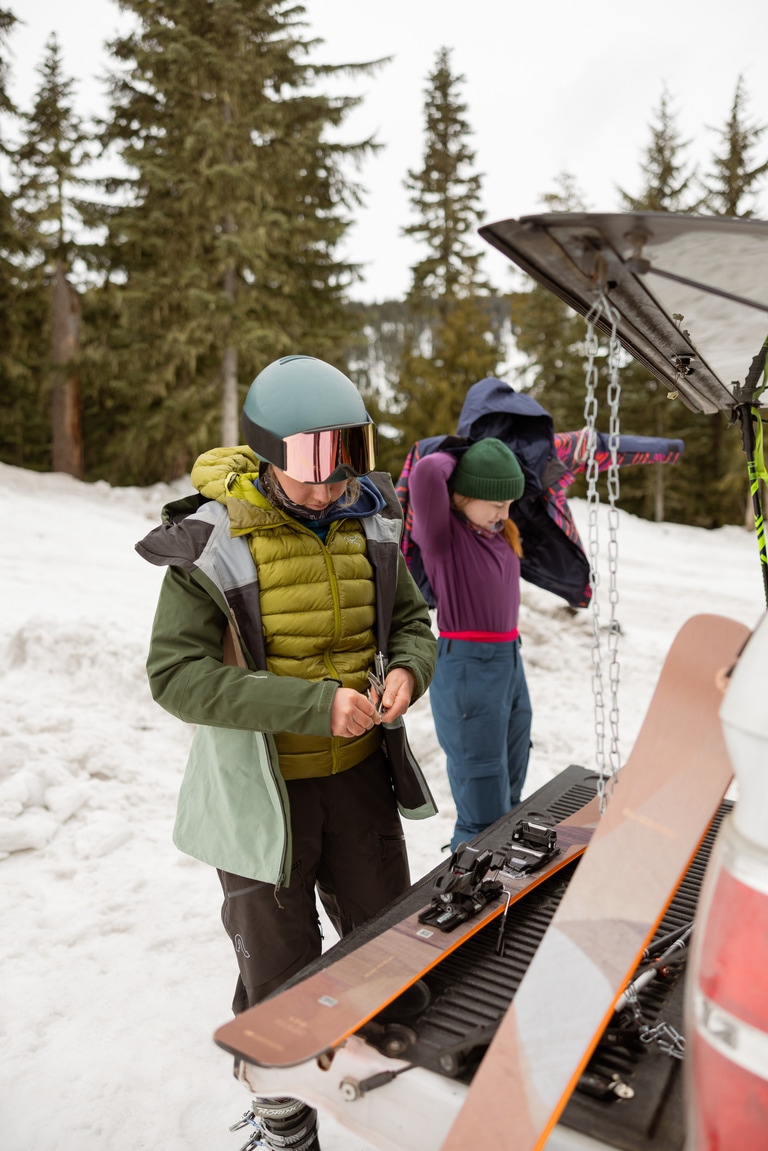 | 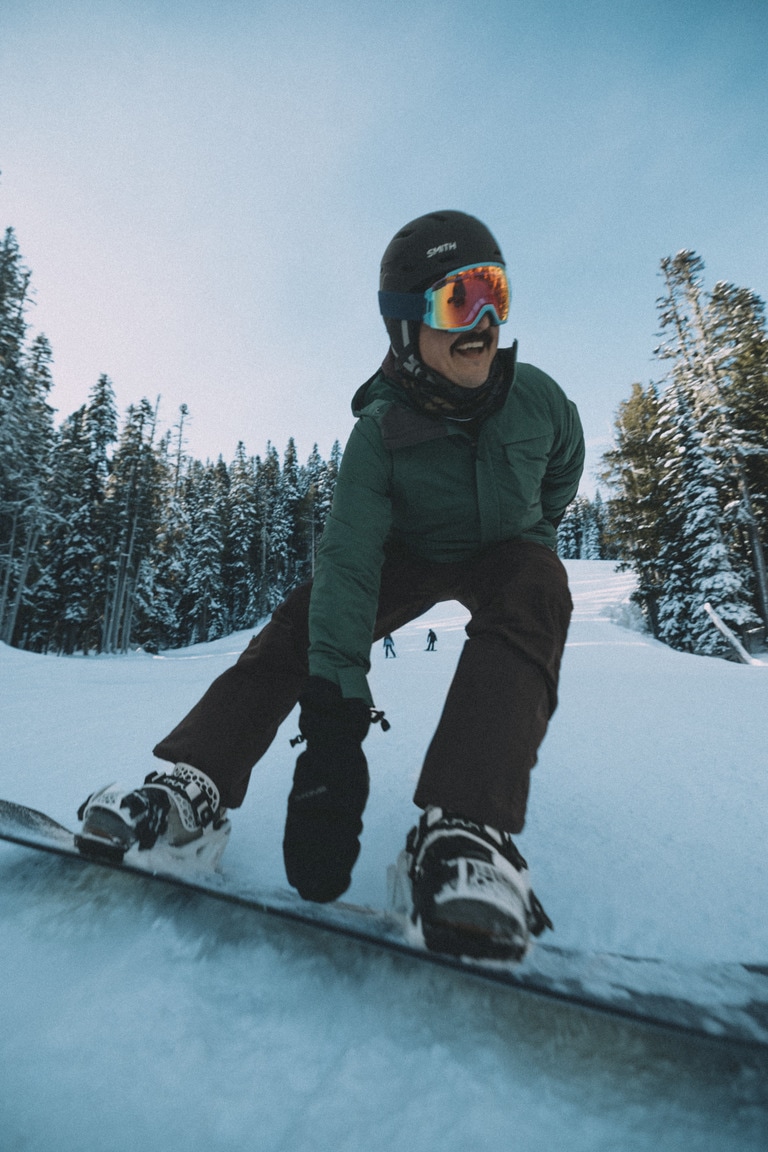 |
It’s cold when you’re skiing or snowboarding, and precipitation in the form of snow (yay!) or rain (ugh) is often in the forecast. For maximum versatility, consider combining an insulated mid layer with a waterproof, breathable shell.
If you tend to run cold and aren't constrained by budget, you might opt for a down puffy jacket. But there are plenty of synthetic and hybrid jackets that can keep you warm on the slopes, too. On blue-sky days or when you’re uphilling, you can ditch the shell.
If you’re a resort skier who runs warm, you may be able to get away with pairing a base layer with an insulated, waterproof, breathable outer layer. Many ski jackets offer insulation to hold in heat, like on the chairlift, and pit zips to cool down after a run.
REI sells 3-in-1 jackets, which pair a mid layer with an outer shell that attach via tabs or a zipper and are popular with resort riders. The mid layer jacket might be filled with synthetic or down insulation like the jackets we’ve described above, or fleece. The shell is usually waterproof and breathable to shield you from the elements. You can wear the mid layer or shell by itself, or the whole thing as one.
Running, Cycling and Cross-Country Skiing

These activities can make you sweat, even in winter. For this reason, opt for a lightweight base layer paired with a hip-length synthetic insulated jacket. The synthetic jacket will do a better job of wicking sweat away from your skin than down. Another benefit: Most synthetic jackets are treated with a durable water repellent to help rain or snow slide off the exterior of the jacket. Shop all insulated running jackets or insulated cycling jackets.
Hiking and Backpacking

Both down and synthetic jackets work on the trail, and you'll find plenty of hiking jackets of both kinds on the market. Which you prefer depends on how and where you plan to use your jacket: What will the conditions be? Will you be wearing it most of the time you're hiking or just during down time, like lunch breaks? Weight and compressibility matter to gram-counting hikers and backpackers, which is why it might make sense to opt for a down or down/synthetic-blend jacket when you’re backpacking. Down and down/synthetic-blend jackets tend to be warmer and lighter than synthetic insulation. Look for options like pockets that are placed slightly higher, which can be comfier while hiking with a pack that secures around your waist. Some can be stuffed into a pocket to become a pillow.
That said, if a synthetic insulated jacket is more in keeping with your budget, don’t fret. There are plenty of packable synthetic jackets on the market. If you think rain could be in the forecast, prioritize synthetic insulation and stash a waterproof shell in your pack. Shop all insulated hiking jackets.
Climbing

Most climbers can get away with a synthetic insulated jacket paired with a lightweight base layer. This is because weight tends to matter less (unless you’re hiking to your climbing spot). That said, if you’re climbing in a spot that tends to get chilly, you run cold or you’ll spend a lot of time belaying in the cold, you may want to opt for the warmth of down or a down/synthetic blend. Look for features like a helmet-compatible hood and pockets that accommodate a hipbelt.
Camping and Casual Wear

Consider the kind of camping you plan to do. If there’s a chance of rain, go with a synthetic insulated jacket or a waterproof insulated jacket. If you’re camping during the shoulder seasons, tend to run cold or care about weight, go with down. If you go that route, pack a water-resistant or waterproof outer layer just in case it rains.
It all comes down to how you plan to use and travel with the garment. “If you’re not going to be traveling or backpacking with something, you may not need it to be compressible,” Ross says. “If you don’t need it to be compressible, you could spend half the price and still get the warmth you need.”
Video: Behind the Design of the REI Co-op Magma 850 Down Jacket
Insulated Jacket Features
Waterproof Construction: Most insulated jackets have a water-resistant exterior or shell. Some feature a waterproof, breathable exterior fabric with taped seams.
Hood: Some are detachable or stow inside the collar. Some are insulated for added warmth. If you're a skier, snowboarder or climber, look for a helmet-compatible hood.
Pockets: Extra pockets offer added storage but also adds weight, bulk and cost.
Adjustment Features
Hood adjusters on the sides or back let you customize fit.
Drawcord: Typically at the bottom hem, it blocks wind and cold air; some have drawcords at the waist.
Front zipper: Most have a chin guard on top and a storm flap. Some longer jackets have a two-way front zip that lets you adjust the bottom opening.
Cuffs: Hook-and-loop wrist tabs that make it easy to adjust fit and seal out wind and cold air.
Vents: Underarm or core vents help regulate heat. You'll find vents more often when a jacket has a waterproof, breathable shell.
Body Mapping: A growing trend is to vary the insulation and shell material based on where it sits on your body, including stretch side panels, less bulky insulation on the sides, waterproof upper surfaces and windproof front panels.
Insulated Jacket FAQs
How do you layer an insulated jacket?
There are many ways to layer an insulated jacket. A good layering system combines a base layer, mid layer, and outer layer or shell.

On a summer evening when you’re camping at a high elevation, you might pair a wool or synthetic base layer with an insulated puffy coat. The insulated jacket serves as both your mid layer and outer layer in this scenario.
If you’re attending a sports event where conditions will be cold and wet, you might pair a wool or synthetic base layer with a down insulated jacket and an insulated, waterproof, breathable outer layer like a parka for maximum warmth.
If you’re downhill skiing or snowboarding in a cold climate where snow is forecast, you might combine a wool or synthetic base layer with a fleece mid layer and an insulated, waterproof, breathable ski jacket.
Read Layering Basics to learn more.
How do I wash my down jacket?
You don’t need to wash your down jacket every time you wear it, but if your jacket looks or smells dirty, it’s time to clean it.
Most down jackets do best when washed with a detergent-free soap like Nikwax Down Wash Direct. An added benefit of the Nikwax wash is that it can help maintain the water resistance of water-resistant down.
After washing, dry your down in the dryer on a low-heat cycle. Add a tennis or dryer ball to your dryer to help revive the down. It can take 1 to 3 hours for the jacket to dry. Afterward, store it on a hanger rather than stuffed into its own pocket. This will help the down maintain its fluffiness—and warmth—over time. Read How to Wash a Down Jacket for more tips on how to keep your jacket clean.
Do synthetic jackets lose warmth over time?
All insulated jackets, synthetic and down, lose warmth over time. “If you’re starting to not feel warm any longer while wearing the jacket, it’s probably the biggest giveaway that it’s time to replace your jacket,” Ross says. Or, if you notice your puffy has lost its puff and you can’t revive it by washing it in the washer and dryer, it may be time to retire it. Read How to Retire Your Gear for advice on how to responsibly donate, resell, recycle, downcycle or dispose of gear at the end of its life.
Why are insulated jackets more expensive?
Insulated jackets tend to be more expensive than jackets without insulation because of the extra material and technology added to the jacket to help keep you warm. But not all insulated jackets are more expensive than jackets without. A fully waterproof, breathable shell jacket with taped seams for skiing, snowboarding or mountaineering, for instance, might cost more than a water-repellent insulated jacket designed for casual wear.
That’s why you want to consider how you plan to use the jacket, how cold you tend to run, and your budget, among other factors, when shopping.


